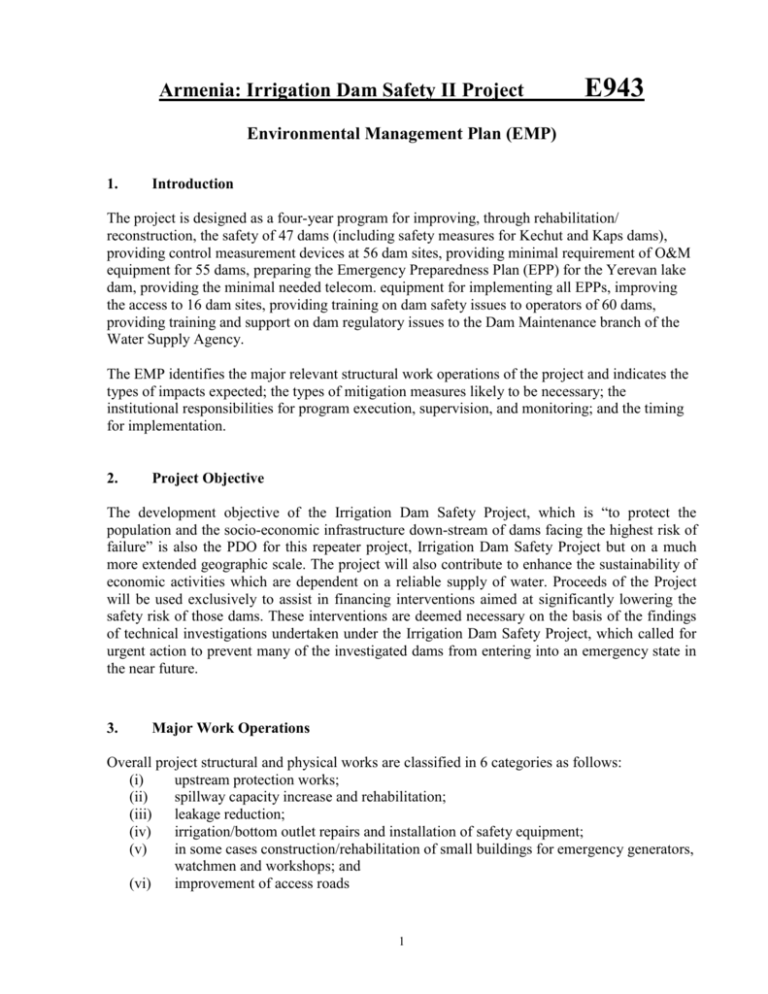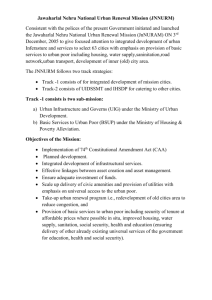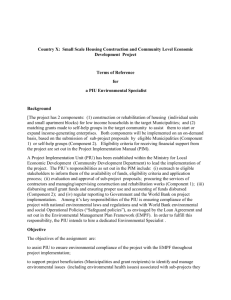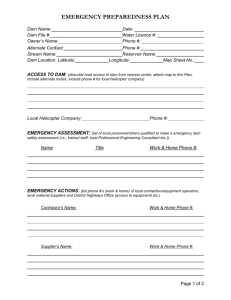Armenia: Dam Safety Project II
advertisement

Armenia: Irrigation Dam Safety II Project E943 Environmental Management Plan (EMP) 1. Introduction The project is designed as a four-year program for improving, through rehabilitation/ reconstruction, the safety of 47 dams (including safety measures for Kechut and Kaps dams), providing control measurement devices at 56 dam sites, providing minimal requirement of O&M equipment for 55 dams, preparing the Emergency Preparedness Plan (EPP) for the Yerevan lake dam, providing the minimal needed telecom. equipment for implementing all EPPs, improving the access to 16 dam sites, providing training on dam safety issues to operators of 60 dams, providing training and support on dam regulatory issues to the Dam Maintenance branch of the Water Supply Agency. The EMP identifies the major relevant structural work operations of the project and indicates the types of impacts expected; the types of mitigation measures likely to be necessary; the institutional responsibilities for program execution, supervision, and monitoring; and the timing for implementation. 2. Project Objective The development objective of the Irrigation Dam Safety Project, which is “to protect the population and the socio-economic infrastructure down-stream of dams facing the highest risk of failure” is also the PDO for this repeater project, Irrigation Dam Safety Project but on a much more extended geographic scale. The project will also contribute to enhance the sustainability of economic activities which are dependent on a reliable supply of water. Proceeds of the Project will be used exclusively to assist in financing interventions aimed at significantly lowering the safety risk of those dams. These interventions are deemed necessary on the basis of the findings of technical investigations undertaken under the Irrigation Dam Safety Project, which called for urgent action to prevent many of the investigated dams from entering into an emergency state in the near future. 3. Major Work Operations Overall project structural and physical works are classified in 6 categories as follows: (i) upstream protection works; (ii) spillway capacity increase and rehabilitation; (iii) leakage reduction; (iv) irrigation/bottom outlet repairs and installation of safety equipment; (v) in some cases construction/rehabilitation of small buildings for emergency generators, watchmen and workshops; and (vi) improvement of access roads 1 The major work operations identified for their potential environmental impacts are: (i) (ii) (iii) (iv) (v) construction of new spillways to increase, where needed, discharge capacities; rehabilitation and reconstruction of existing spillways; slope stabilization and strengthening; rehabilitation of irrigation outlet; and rehabilitation of access roads. Construction of new spillways: According to current plans and designs, new spillways will be required and constructed at 9 dams (Kechut, V. Sasnashen, Gegharkunik-1, Katnaghbiur-2, Khashtarak-2, Hovk-1, Hovk-2, Hovk 1A, N. Bazmaberd). The new constructions will bring their total spillway discharge capacity (existing plus new capacities) to socially acceptable levels. This is badly needed for safety purposes as overtopping is considered the most critical failure mechanism for embankment dams. The major environmental issue related to the spillway construction work would be the disposal of excavated materials (soil, stone, gravel, spoils, etc.). In general, volumes of excavated materials are relatively small and manageable. Rehabilitation/Reconstruction of Existing Spillways: Rehabilitation/reconstruction work is currently planned on 20 existing spillways (Akhurian, Spandarian, Tolors, Shamb, Aghavnadzor, Tsilkar, Kosh, Agarak, Ashnak-2, Vosketas, Metsavan, Maralik, Khashtarak-1, Getik, Shenik, Angechakot, Yerevan Lake, N. Talin, Karaglukh, Martiros-1). The work will vary from site to site from complete reconstruction to minor repair. The major environmental issue of the spillway rehabilitation/reconstruction work would be the transport and disposal of the concrete rubble and debris. Slope Protection/Strengthening: The project is currently expected to improve the slope protection of 22 dams (Spandarian, Tolors, Aghavnadzor, Tsilkar, Katnaghbiur-1, Davidashen, Talish, V. Talin-1, Ashnak-2, Maralik, Ashnak-1, Irind, Katnaghbiur-2, V. Sasnashen, Saralich, Artavan, Khashtarak-2, Hovk-1A, Hatsashen, Shgarshik, V. Talin-2, Gegharkunik-1). Depending on each case, this would require the strengthening of one (generally, on the reservoir side) or both of the dam slopes. Damaged slope concrete covers will have to be removed and either disposed off or reused, if suitable. Rehabilitation of irrigation outlet: Rehabilitation of irrigation outlet is currently planned on 20 existing dams (Joghaz, Akhurian, Kechut, Shenik, Tsilkar, Aghakchi, Kosh, Talish, V. Talin-1, Metsavan, Ashnak-1, Gegharkunik-1, Egnik, Hovk-1, Kaps, Aragats, Angechakot, Aknalich, Yerevan Lake, Hatsashen). The major environmental issue related to the spillway construction work would be the disposal of excavated materials (soil, stone, gravel, spoils, etc.) and construction wastes (concrete rubbles and debris). In general, volumes of excavated materials are relatively small and manageable. According to current plans and designs, new safety equipments will be installed at all dams included in this project and no major environmental problems are anticipated during this process. Rehabilitation of access roads The project is currently expected to improve the access roads of 16 dams (Aghakchi, Davidashen, Metsavan, Irind, Agarak, V. Sasnashen, Arpilich, Saralich, Aygedzor, Tavshud, David-Bek, 2 Aparan, Karnout, Mantash, Hakhoum, Akhurian). The major environmental issue related to the rehabilitation of access roads would be the disposal of excavated materials (soil, stone, gravel, spoils, etc.). In general, volumes of excavated materials are small and manageable. 4. Potential Impacts Considering the rehabilitation nature of the project and the type of works considered to be carried out at this stage, the negative impacts on the environment are expected to be insignificant or minor. Based on the preliminary assessment, these impacts would be limited to: (i) The transport and disposal of inert materials and construction concrete rubbles and debris; and (ii) The use and transport of materials (stone, gravel, soil, etc) from old and/or new quarries. The positive impacts are, on the other hand, expected to be significant. Over 23000 persons (affected population) would enjoy better protection and safety after completion of the project. The water resource and the Dam-based socio-economic activities and infrastructures and those in downstream areas would also be better protected. Dam operations will be better managed and sustained (reducing the need for new dams and for more impacts on the environment). Dam warning and emergency systems will be improved and O&M function will be strengthened 5. Mitigation Measures Based on the preliminary assessment, key mitigation measures recommended under this preliminary Environmental Management Plan (EMP) are listed as follows per item and issue: a) b) Spillway Construction, where possible, of tunnel waterways in place of open trenches which are more exposed to hill stone and landslides and garbage dumping and which change/damage the landscape; Widening, where possible, existing spillways to increase capacity and avoid construction of new ones; Obtain permits from the Ministry of Nature Protection (MNP) and as needed from the local/regional authorities for disposal of excavated materials and construction wastes; Obtain permit from the MNP and concerned Local/ Regional Authorities for opening and/or use of quarries. Transport and disposal of construction concrete rubbles, debris and spoils in approved paths and landfills/dump sites; Restoration to quasi-original conditions of landscape after completion of construction and rehabilitation works. Slope, outlet Reuse of suitable excavated and dredged materials (e.g. from spillway operations) for slope protection and strengthening works, limiting the need for old and new quarries; Use, where possible, existing quarries for required additional materials; Obtain permits from the Ministry of Nature Protection and as needed from the local/regional authorities for the opening and/or use of quarries; Obtain permits from the Ministry of Nature Protection and as needed from the local/regional authorities for disposal of excavated materials and construction wastes; 3 Restoration to quasi-original conditions of landscape after completion of construction and rehabilitation works and after use of quarries. c) Access roads Rehabilitation, where possible, of existing access roads avoiding construction of new ones; Restoration to quasi-original conditions of landscape after completion of construction and rehabilitation. 6. Environmental management Mitigation Measures and Institutional Responsibilities for Implementation For each potential impact Table 1 identifies: the proposed mitigation measure(s); and the parties or agencies charged with implementing those measures, separated into: -- executing agencies, responsible for executing the measure; -- supervising agencies, responsible for supervising the executing agencies to ensure that they execute the mitigation measures as planned; and -- monitoring agencies, in charge of monitoring the extent of implementation and the effectiveness of the mitigation measures and of adjusting the program if needed. The proposed mitigation measures and institutional responsibilities are grouped as follows, depending on the identity of the monitoring agency: World Bank (WB): includes all measures calling on the PIU and associated design institutes to obtain EA conclusion, permits for water use and discharge and for the disposal of excavated materials, wastes, and demolition debris. The World Bank will need to ensure that such permits are obtained from relevant agencies (MNP, Local and regional authorities) before the construction works are tendered out; PIU: includes all measures implemented by contractors/operators, and other institutes, supervised by institutes affiliated with the SCWM, and monitored by the PIU; and Partner agencies to the PIU and SCWM: includes all measures requiring some sort of monitoring by key partners of the PIU/SCWM for this project, in particular the MNP and its affiliated agencies (Water Resources Protection Agency, Historic and Cultural Monuments Protection Agency, etc.). 7. Contracting Most construction phase impacts will be possible to mitigate by including appropriate clauses into the civil works contacts. Clauses should cover, but not limited to, the following issues: Compliance with general national environmental guidelines; Protection of Historic-cultural monuments; Adequate disposal of construction and excavation wastes; Location of construction camps, etc. The construction site, potential negative impacts, mitigation measures, implementing institutions and timing are presented in Table 1. 4 SITE POTENTIAL NEGATIVE IMPACT ENVIRONMENTAL MITIGATION OR MONITORING MEASURES EXECUTING AGENCY SUPERVISING AGENCY MONITORING AGENCY TIMING MONITORING AGENCY TIMING Armenia: Irrigation Dam Safety II Project Table 1: Environmental Management Plan (EMP) SITE POTENTIAL NEGATIVE IMPACT ENVIRONMENTAL MITIGATION OR MONITORING MEASURES EXECUTING AGENCY SUPERVISING AGENCY CONSTRUCTION OF NEW SPILLWAYS * Kechout, * V. Sasnashen, * Gegharkunik-1, * Katnaghbiur-2, * Khashtarak-2, * Hovk-1, * Hovk-2, * Hovk 1A * N. Bazmaberd Open cuts and trenches may damage landscape. Pollution of water and soil as a result of improper disposal of excavated materials and construction wastes Construct tunnel waterways, where possible, in lieu of open trenches. Design Institute/ Contractor PIU Ministry of Nature Protection (MNP) Investigate during design phase and implement according to Time-schedule Widen existing spillways, where possible, in lieu of new ones. Design Institute/ Contractor PIU MNP Investigate during design phase and implement according to Time-schedule Obtain permit from the MNP and concerned Local/ Regional Authorities for construction and disposal operations. Provide for zones of preliminary accumulation of wastes that will cause no damage to the vegetation cover and other components of the environment Design Institute PIU WB During detailed design phase Contractor, Construction sub-contractor organizations PIU MNP After obtaining of permit, during construction work Arrange disposal all types of wastes according to the established procedure and in the area designated for the specific purpose. Contractor, Construction sub-contractor organizations PIU MNP Local/Regional Authority After obtaining of permit, during construction work Recuperate suitable excavated materials for slope protection/ strengthening works. Contractor PIU MNP Local/Regional Authority As per Timeschedule for slope protection/ strengthening works 5 SITE POTENTIAL NEGATIVE IMPACT Loss of top soil due to temporary access roads and work areas Temporary air pollution (dust) related to the transportation of construction materials and truck traffic Impacts on historiccultural monuments (in case of Kechut dam) ENVIRONMENTAL MITIGATION OR MONITORING MEASURES EXECUTING AGENCY SUPERVISING AGENCY MONITORING AGENCY TIMING Delineate access roads/ work areas carefully and prevent their expansion Contractor PIU MNP Local/Regional Authority During construction works Restore temporary roads re-using excavated soil up to the restoration of the vegetation cover Rehabilitate access roads and work areas after work completion (scratch soil with special engine, put fertile topsoil in place, etc.) Use closed/covered trucks for transportation of construction materials Contractor PIU MNP During construction works Contractor PIU MNP After works completion. Contractor, Construction sub-contractor organizations Contractor PIU MNP During construction works PIU MNP During/ after construction works Contractor PIU MNP, Historic and Cultural Monuments Protection Agency During construction works Contractor PIU MNP, Historic and Cultural Monuments Protection Agency During construction works Clean the surrounding area from dust by water sprinkling , removal of excess materials and cleaning of sites upon completion of activities Arrange necessary preservation measures (establish protection zones, by-pass these areas during transportation and other); Cease the works as soon as historical and cultural monuments are encountered during earthworks and provide relevant information to the State Agency for Historical and Cultural Monuments Protection. 6 SITE POTENTIAL NEGATIVE IMPACT Landscape degradation ENVIRONMENTAL MITIGATION OR MONITORING MEASURES Restoration to quasi-original conditions of landscape after completion of reconstruction and rehabilitation works and after use of quarries. EXECUTING AGENCY SUPERVISING AGENCY MONITORING AGENCY MNP TIMING Contractor, Construction sub-contractor organizations PIU After works completion. Recuperate suitable construction rubbles, debris and spoils for slope protection work. Contractor, Construction sub-contractor organizations PIU MNP Local/Regional Authority As per Time-schedule for slope protection/ strengthening work Obtain permit from the MNP and concerned Local/ Regional Authorities for opening and/or use of quarries. Obtain permit from the MNP and concerned Local/ Regional Authorities for construction and disposal operations. Design Institute PIU WB During detailed design phase Design Institute PIU WB During detailed design phase Transport and dispose off leftover materials in approved paths and dump sites Contractor, Construction sub-contractor organizations PIU MNP Local/Regional Authority After obtaining of permit and during rehabilitation/ reconstruction work Use closed/covered trucks for transportation of construction materials Contractor, Construction sub-contractor organizations Contractor PIU MNP During construction works PIU MNP During/ after construction works REHABILITATION/ RECONSTRUCTION OF EXISTING SPILLWAYS * Akhurian, * Spandarian, * Tolors, * Shamb, * Aghavnadzor, * Tsilkar, * Shenik, * N. Talin, * Kosh, * Davidashen, * Agarak, * Ashnak-2, * Vosketas, * Metsavan, * Maralik, * Khashtarak-1, * Karaglukh, * Getik, * Angechakot, * Yerevan Lake, * Martiros-1 Pollution of water and soil as a result of improper disposal of excavated materials and construction wastes Temporary air pollution (dust) related to the transportation of construction materials and truck traffic Clean the surrounding area from dust by water sprinkling , removal of excess materials and cleaning of sites upon completion of activities 7 SITE POTENTIAL NEGATIVE IMPACT Landscape degradation ENVIRONMENTAL MITIGATION OR MONITORING MEASURES Restoration to quasi-original conditions of landscape after completion of reconstruction and rehabilitation works and after use of quarries. EXECUTING AGENCY SUPERVISING AGENCY MONITORING AGENCY MNP TIMING Contractor, Construction sub-contractor organizations PIU After work completion. Contractor, Construction sub-contractor organizations Contractor PIU PIU MNP To be decided during detailed design phase Design Institute PIU WB During detailed design phase Design Institute PIU WB During detailed design phase Contractor, Construction sub-contractor organizations PIU MNP After obtaining of permit and during rehabilitation/ reconstruction work Contractor, Construction sub-contractor organizations Contractor PIU MNP During construction works PIU MNP During/ after construction works Contractor PIU MNP After completion of protection/ strengthening work SLOPE PROTECTION/ STRENGHTENING Spandarian, Tolors, Aghavnadzor, Tsilkar, Katnaghbiur-1, Davidashen, Talish, V. Talin-1, Ashnak-2, Maralik, V. Sasnashen, Ashnak-1, Irind, Katnaghbiur-2, N. Bazmaberd, * Saralich, * Artavan, * Khashtarak-2, * Hovk-1A, * Hatsashen, * Shgarshik, * V. Talin-2, * Gegharkunik-1. Requires volumes of gravel, stones, soil, etc. Recuperate suitable materials from other rehabilitation and reconstruction works (e.g. new and old spillways, slopes). Requires use of either existing quarries or the opening of new ones. Possible production of construction debris/spoils. In priority, use old quarries for additional materials and if not possible, open new quarries located, where possible, in reservoir flood areas. Obtain permit from the MNP and concerned Local/ Regional Authorities for opening and/or use of quarries. Obtain permit from the MNP and concerned Local/ Regional Authorities for construction and disposal operations. Arrange disposal all types of wastes according to the established procedure and in the area designated for the specific purpose. Temporary air pollution (dust) related to the transportation of construction materials and truck traffic Landscape degradation Use closed/covered trucks for transportation of construction materials Clean the surrounding area from dust by water sprinkling , removal of excess materials and cleaning of sites upon completion of activities Restoration to quasi-original conditions of landscape after completion of reconstruction and rehabilitation works. REHABILITATION OF IRRIGATION OUTLET 8 After completion of work on spillways SITE Joghaz, Akhurian, Kechut, Kaps, Shenik, Talish, Tsilkar, Aghakchi, Kosh, V. Talin-1, Metsavan, Ashnak-1, Gegharkunik-1, Egnik, Hovk-1, N. Bazmaberd, Aragats, Angechakot, Aknalich, Yerevan Lake * Hatsashen POTENTIAL NEGATIVE IMPACT ENVIRONMENTAL MITIGATION OR MONITORING MEASURES Possible production of construction debris/spoils. Obtain permit from the MNP and concerned Local/ Regional Authorities for construction and disposal operations. Design Institute PIU WB During detailed design phase Arrange disposal all types of wastes according to the established procedure and in the area designated for the specific purpose. Restoration to quasi-original conditions of landscape after completion of reconstruction and rehabilitation works. Contractor, Construction sub-contractor organizations Contractor PIU MNP PIU MNP After obtaining of permit and during rehabilitation/ reconstruction work After work completion. Obtain permit from the Ministry of Nature Protection and concerned Local/ Regional authorities for disposal operation. Arrange disposal all types of wastes according to the established procedure and in the area designated for the specific purpose. Design Institute PIU WB During detailed design phase Contractor, Construction sub-contractor organizations PIU MNP After obtaining of permit and during rehabilitation/ reconstruction work Restoration to quasi-original conditions of landscape after completion of reconstruction and rehabilitation works. Contractor PIU MNP After work completion. Landscape degradation EXECUTING AGENCY SUPERVISING AGENCY MONITORING AGENCY TIMING IMPROVEMENT OF ACCESS ROADS Aghakchi, Davidashen, Metsavan, Irind, Agarak, V. Sasnashen, Arpilich, Saralich, Aygedzor, Tavshud, David-Bek, Aparan, Karnout, Mantash, Hakhoum, Akhurian Possible production of construction debris/spoils. Landscape degradation 9 DISCLOSURE REPORT This report presents the Minutes of the disclosure addressing the “IRRIGATION DAM SAFETY II PROJECT” and particularly the “ENVIRONMENTAL MANAGEMENT PLAN”, that was held at the PIU Meeting Room on April 30, 2004. The report includes the following principal sections: 1. Pre-requisites of the disclosure 2. Disclosure Program 3. Objectives of the disclosure 4. List of participants 5. Key questions and opinions expressed during the disclosure 1. Pre-requisites of the Disclosure The RA Government, International Development Association and World Bank support implementation of the Environmental Management Plan under the ”Irrigation Dam Safety Project IIl”. The present Environmental Management Plan (EMP) has been prepared by the PIU specialists with the World Bank assistance. 2. Disclosure Program The Seminar Program consisted of the following. Opening speech – Adibek Ghazaryan, director, WSDII PIU SI Presentation of the Project – Karen Grigoryan, project coordinator, WSDFII PIU SI Presentation of the Environmental Management Plan – Armine Simonyan, environmental specialist, WSDII PIU SI Discussion 3. Objectives of the Disclosure The objectives of the disclosure were to: Present the activities to be conducted under Irrigation Dam Safety II Project. 10 Present the activities to be conducted under the IDSP II Environmental Management Plan Keep concerned parties informed about the Project from its starting point. The seminar was organized in two parts. During the first part, after the opening and welcoming speech, Dr. Karen Grigoryan (Project coordinator) presents general information on the proposed project, identify the key activities to be undertaken, focus participants attention on Marmarik, Kaps and Kechout dams. During the second part Ms. Armine Simonyan presented the IDSP II Environmental Management Plan, indicate the types of of impacts expected, identify the types of mitigation measures likely to be necessary, institutional responsibilities for measures execution, supervision and monitoring. 4. List of Participants No Organization Name and Surname Position 1. State Committe for Water Management under RA Government Rudik Ghukasyan Deputy minister 2. WSA, Dams department Robert Andreasyan Head of department 3. WSA, Dams department Aram Melkumov Chief engineer 4. Technical Consultative Commission Hovhannes Tockmajyan Head of Commission 5. WSA, “Aknurian - Araks” branch Slavik Ishkhanyan Head of branch 6. Emergency management Agency Artak Hakobyan Representative 7. WSDII PIU Adibek Ghazaryan Director 8. WSDII PIU Karen Grigoryan Project Coordinator 9. WSDII PIU Edik Gndolyan Chief engineer 10. WSDII PIU Armine Simonyan Environmental specialist 5. Key questions and opinions expressed during the disclosure Question: Operation agency needs typical standard regulations on dam operation, safety certificate as well as ranges of safety indicators. 11 Answer: Consulting services on study of regulatory framework for dam safety is already included in the project. Abovementioned issues will be included in TOR as far as possible and will get relevant solution. Question: Was the dam Bartsrouni included in the IDSP II? Answer: Dam Bartsrouni is not included in the project due to the following reasons. Dam possess no risk in it’s current state as it is not filled. It is located on a landslide. Even in case of dam failure no threat is anticipated due to the dam small storage. No measures are provided as a result of technical investigations, it isn’t subject to rehabilitation. 12








